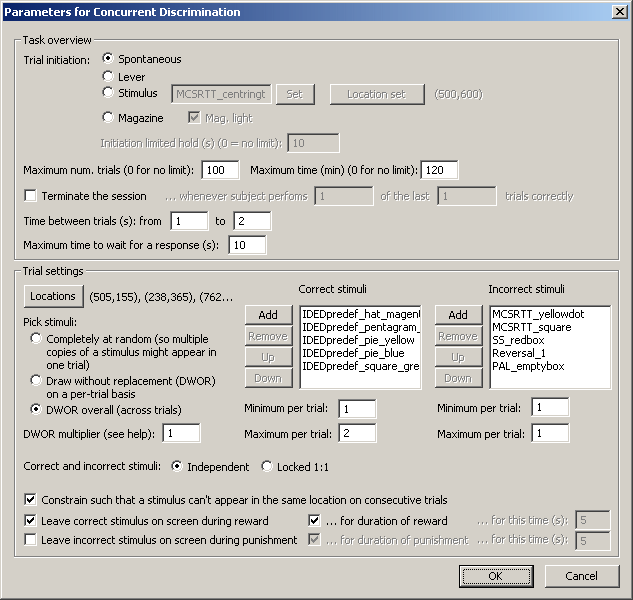Summary
Presents multiple visual stimuli together and rewards touching some, but not others.
About the task
| • | Each trial begins with a Marker 1 sound (optionally, following an initiation response). |
| • | Stimuli appear in various locations on the screen. Some stimuli are correct; some are incorrect. |
| • | The first response to a stimulus is registered, and the subject receives reward/punishment accordingly (or, if it fails to respond, an omission occurs and is punished). |
By default the task considers a separate set of correct and incorrect stimuli; however, you can also lock the correct stimulus list and the incorrect stimulus list together, creating a n-pair concurrent discrimination task (in which paired stimuli always appear together).
Configuring the task

| • | Trial initiation. Specify the initiation method (spontaneous, requiring a lever response, requiring a response to a stimulus on a touchscreen, requiring a magazine response). For stimulus initiation, you can set its appearance and location. For magazine initiation, you can have the magazine light illuminated to indicate the need for a response. For initiation methods other than "spontaneous", specify also the initiation limited hold time (after which failure to respond causes the trial to be abandoned; use 0 for no limit). See also Use with Dogs. |
| • | Maximum number of trials. When the subject has performed this number of trials, the task ends. (You may specify 0 for no limit, though you must specify a limit on the number of trials, the time, or both. |
| • | Maximum time. When this time elapses, the task is terminated as soon as the current trial has finished. (You may specify 0 for no limit, though you must specify a limit on the number of trials, the time, or both.) |
| • | Terminate the session... optionally, you can have the session terminate when the subject performs X of the last Y trials correctly (you specify X and Y). |
| • | Time between trials. Specify a minimum and a maximum intertrial time (they may be the same). The actual time is chosen with a rectangular probability distribution within these values. The time between trials starts after any reward or punishment from the previous trial has finished. |
| • | Maximum time to wait for a response. Once stimuli have been presented, this is the time that the program will wait for a response before abandoning the trial as an omission. |
| • | Locations. Click to choose the Locations used for the stimuli. |
| • | Pick stimuli... This can be (a) completely at random, in which every stimulus is drawn (with replacement) from the relevant list of stimuli. This may result in multiple copies of a stimulus appearing on the screen. (b) Draw-without-replacement (DWOR) on a per-trial basis. Every trial begins with the creation of a 'pool' of correct stimuli, and a 'pool' of incorrect stimuli, each created by taking the correct/incorrect list and making as many copies of it as the DWOR multiplier, which you specify. Individual stimuli are then drawn without replacement from this pool (correct stimuli from the correct pool, and incorrect stimuli from the incorrect pool). (c) DWOR overall (across trials). In this method, exactly the same method as (b) is used, but the DWOR pools are not reset between trials - only when the pools are too small to create an entire trial from. See also randomness, pseudorandomness, and drawing without replacement. |
| • | Correct stimuli. Specify your list of correct stimuli, and the minimum/maximum number of correct stimuli per trial. (The actual number is drawn randomly from a rectangular probability distribution between these limits.) |
| • | Incorrect stimuli. Likewise. |
| • | Correct and incorrect stimuli: independent? Locked 1:1? If you choose "independent", then a certain number of correct stimuli are selected and shown on each trial, and, independently, a certain number of incorrect stimuli are selected and shown. If you choose "locked 1:1", then the correct stimulus list and the incorrect stimulus list are considered as a sequence of pairs. This means: (a) that the correct and incorrect lists must be of the same length; (b) that you cannot specify the number of incorrect stimuli independent of the number of correct stimuli (so those options disappear); (c) on each trial, the task picks a certain number (between the minimum and maximum inclusive) of correct stimuli, with their paired incorrect stimuli, and shows those. As an example: to produce an 8-pair concurrent discrimination task, of which one pair is shown on each trial, specify a list of 8 correct stimuli, a list of 8 incorrect stimuli in corresponding order, choose "locked 1:1", and specify a minimum of 1 correct stimulus and a maximum of one correct stimulus per trial. |
| • | Constrain such that a stimulus can't appear in the same location on consecutive trials. Does what it says on the tin. Specifying this option makes the task require enough unique stimuli that it can be sure to satisfy this constraint. |
| • | Leave correct stimulus on during reward? (etc.) When the subject responds, the chosen correct stimulus can be left on the screen during reward, and/or the chosen incorrect stimulus can be left on during punishment. These stimuli can either be left on for the duration of the reward/punishment (as specified in the General Parameters), or you can specify how long to leave them on the screen for. |